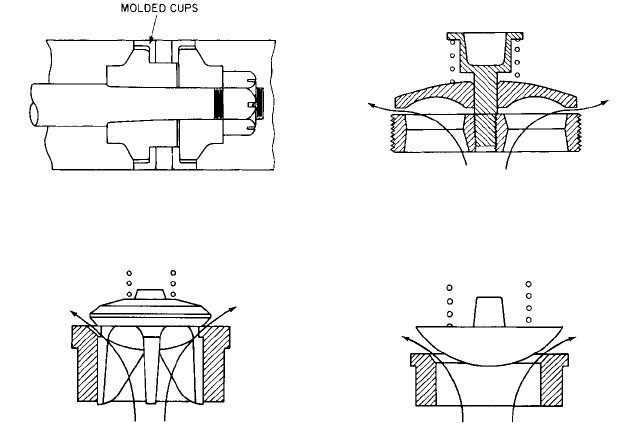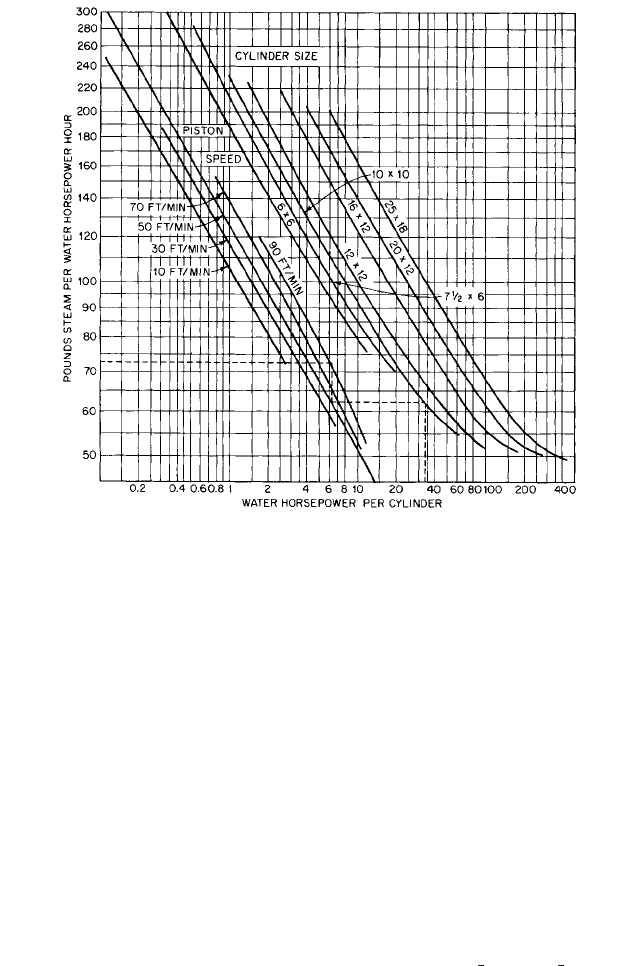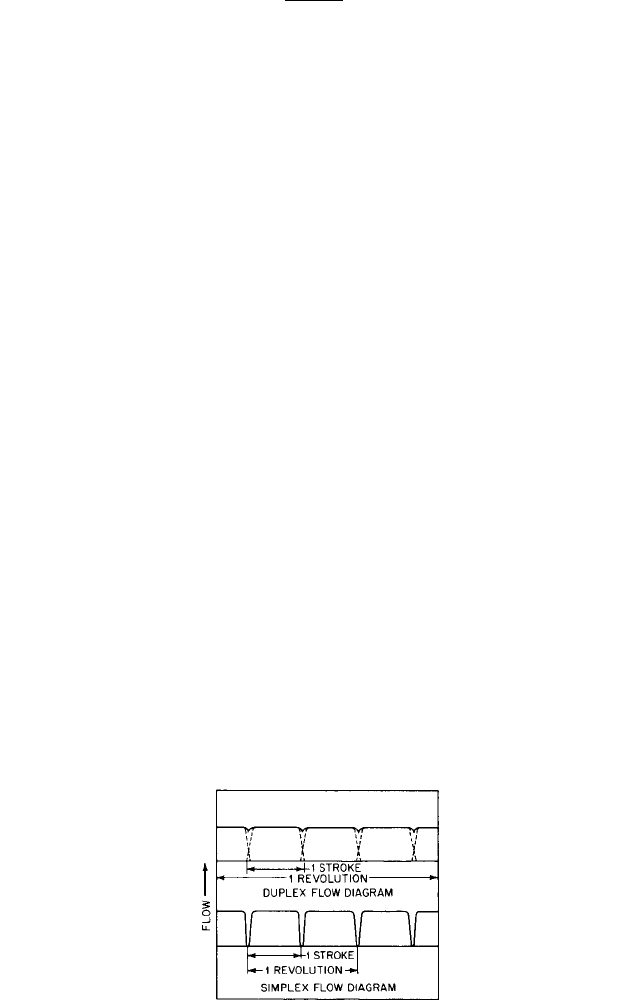Pump Handbook by Igor J. Karassik, Joseph P. Messina, Paul Cooper, Charles C. Heald - 3rd edition
Подождите немного. Документ загружается.


3.52 CHAPTER THREE
installed in the center of the stuffing box with packing rings on both sides of it. A drilled
hole is provided through which a lubricant, grease or oil, can be injected into the lantern
ring from the outside of the stuffing box. At higher temperatures, approximately 500°F
(260°C) or higher, a cooling water jacket is added to the outside of the stuffing box or as a
spacer between the stuffing box and the liquid cylinder. The purpose of the cooling water
jacket is to extend packing life by keeping the packing cool.
The liquid end valves of all direct-acting steam pumps are self-acting, in contrast to the
mechanically operated slide valves in the steam end. The liquid end valves act like check
valves; they are opened by the liquid passing through and are closed by a spring plus their
weight.
Liquid end valves are roughly divided into three types: the disk valve for general ser-
vice and thin liquids, the wing-guided valves for high pressures, and either the ball or the
semispherical valve for abrasive and viscous liquids.
The valve shown in Figure 20 is typical of the disk type. This stem-guided design is
commonly used in the cap-and-valve plate design. For hot-water boiler-feed and general
service, the disk, seat, and stem are usually made of bronze, although other alloys may
also be used. For lower temperatures and pressures, the disk may be made of rubber,
which has the advantage of always forming a tight seal with the valve seat.
The wing-guided valve shown in Figure 21 is typical of the design use for high pres-
sures. It derives its name from the wings on the bottom of the valve, which guide it in its
seat. The beveled seating surfaces on the valve and seat tend to form a tighter seal than
the flat seating surfaces on a disk valve. There is also less danger that a solid foreign par-
ticle in the liquid will be trapped between the seat and the valve.This type of valve is com-
monly made from a heat-treated chrome-alloy-steel forging, although a cast hard bronze
and other materials may be used.
The ball valve, as its name suggests, is a ball that acts like a check valve. It is usually
not spring-loaded, but guides and lift stops are provided as necessary to control its opera-
tion. The ball may be made of rubber, bronze, stainless steel, or other materials as service
conditions require.The semispherical valve (Figure 22) is spring-loaded and can therefore
be operated at higher speeds than the ball valve. Both the ball and the semispherical type
FIGURE 19 Body-and-follower piston with molded
cups
FIGURE 20 Stem-guided disk valve
FIGURE 21 Wing-guided valve
FIGURE 22 Semispherical valve
3.3 STEAM PUMPS 3.53
have the advantage of having no obstructions to flow in the valve seat (the disk valve seat
has ribs and the wing-guided valve has vanes which obstruct the flow).The one large open-
ing in the seat and the smooth spherical surface of ball and semispherical valves minimize
the resistance to flow of viscous liquids. These types are also used for liquids with sus-
pended solids because their rolling seating action prevents trapping of the solids between
the seat and valve.
Plunger-Type Liquid Ends As mentioned previously, plunger-type pumps are used
where dependability is of prime importance, even when the pump is operated continuously
for long periods and where the pressure is very high. Cast liquid end plunger pumps are
used for low and moderate pressures. Forged liquid end pumps (Figure 23), which are the
most common plunger types, are used for high pressures and have been built to handle
pressures in excess of 10,000 lb/in
2
(69 MPa).
Most of these designs have opposed plungers; that is, one plunger operating into the
inboard end of the liquid cylinder and one into the outboard end. The plungers are solidly
secured to inboard and outboard plunger crossheads. The inboard and outboard plunger
crossheads are joined by side rods positioned on each side of the cylinder. With this
arrangement, each plunger is single-acting; that is, it makes only one pressure stroke for
each complete reciprocating cycle. The pump, however, is double-acting because the
plungers are connected by the side rods.
PLUNGER PUMP LIQUID END MATERIALS The liquid cylinder of a forged liquid end plunger-
type pump is most commonly made from forged steel, although bronze, Monel, chrome
alloy, and stainless steels are also used. The stuffing boxes and valve chambers are usu-
ally integral with the cylinder (Figure 23), which is desirable for higher temperatures and
pressures because high-temperature joints are minimized.
The liquid plungers may be made of a number of materials. The plungers must be as
hard and smooth as possible to reduce friction and to resist wear by the plunger packing.
Hardened chrome-alloy steels and steel coated with hard-metal alloys or ceramics are
most commonly used.
The stuffing box packing used will vary widely depending upon service conditions. A
soft, square packing cut to size may be used. However, solid molded rings of square, V-lip,
or U-lip design are commonly used at higher pressures. Oil or grease is frequently injected
into a lantern ring in the center of the stuffing box to reduce friction and reduce packing
and plunger wear.
The liquid valves may be of any of the types or materials described above. However, the
wing-guided valve with beveled seating surfaces is the most common because it is most
suitable for high pressures.
DIRECT-ACTING STEAM PUMP PERFORMANCE __________________________
The direct-acting steam pump is a very flexible machine. It can operate at any point of pres-
sure and flow within the limitations of the particular design. The speed of, and therefore the
flow from, the pump can be controlled from stop to maximum by throttling the steam supply.
This can be done by either a manual or an automatically operated valve in the steam supply
line. The maximum speed of a particular design is primarily limited by the frequency with
which the liquid valves will open and close smoothly.The pump will operate against any pres-
sure imposed upon it by the system it is serving, from zero to its maximum pressure rating.
The maximum pressure rating of a particular design is determined by the strength of the liq-
uid end. In a particular application, the maximum liquid pressure developed may be limited
by the available steam pressure and by the ratio of the steam piston and liquid piston areas.
STEAM PUMP CAPACITY ______________________________________________
The flow to the discharge system is termed the pump capacity. The capacity, usually
expressed in U.S. gallons per minute (cubic meters per minute), is somewhat less than the

3.54
FIGURE 23 Simplex plunger pump with forged steel cylinder:
(1) steam cylinder with cradle, (2) steam cylinder head, (3) steam cylinder foot, (7) steam piston, (9) steam piston rings,
(11) slide valve, (12) piston valve, (18) steam chest, (19) steam chest cover, (22) steam chest head, (24) valve rod stuffing box gland, (26) steam piston rod stuffing box gland, (33) steam
piston rod, (35) steam piston rod nut, (36) plunger nut, (38) cross stand, (39) lever, (42) fulcrum pin, (44) crank, (47) tappet, (49) valve rod link, (49A) valve rod link head, (52) lost-motion
adjusting nut, (53) lost-motion locknut, (54) valve rod, (57) valve rod head, (61) liquid cylinder foot, (73) plunger, (75) plunger lining, (76) plunger gland flange, (77) plunger gland lining,
(78) side rod, (78A) side rod guide, (82) plunger crosshead, front; (84) metal valve, (86) valve seat, (87) valve spring, (96) steam cylinder drain valve, (254) piston rod stuffing box bushing,
(431) lever key, (432) crank key, (571) valve rod head pin, (585) liquid cylinder, (781) side rod nut, (821) plunger crosshead, rear, (891) suction valve plug, (945) crosshead pin, (2612) lantern
gland, (8911) discharge valve plug, (3411) steam piston rod jam nut (Flowserve Corporation)

3.3 STEAM PUMPS 3.55
theoretical displacement of the pump. The difference between displacement and capacity
is called slip. The displacement is a function of the area of the liquid piston and the speed
at which the piston is moving.
The displacement of a single double-acting piston can be calculated from the formula
in USCS units
in SI units
where D displacement, gpm (m
3
/min)
A area of piston or plunger, in
2
(mm
2
)
S piston speed, ft/min (m/min)
d diameter of the liquid piston or plunger, in (mm)
For a duplex double-acting pump, D is multiplied by 2. This formula neglects the area
of the piston rod. For very accurate calculations, it is necessary to deduct the rod area from
the piston area. This is normally not done, and the resultant loss is usually considered part
of the slip.
The slip also includes losses due to leakage from the stuffing boxes, leakage across the
piston on packed-piston pumps, and leakage back into the cylinder from the discharge side
while the discharge valves are closing. Slip for a given pump is determined by a test. For a
properly packed pump, slip is usually 3 to 5%. As a pump wears, slip will increase, but this
can be compensated for by increasing the pump speed to maintain the desired capacity.
PISTON SPEED ______________________________________________________
Although piston speed in feet per minute (meters per minute) is the accepted term used to
express steam pump speed, it cannot easily be measured directly and is usually calculated
by measuring the revolutions per minute of the pump and converting this to piston speed.
One revolution of a steam pump is defined as one complete forward and reverse stroke of
the piston. The relationship between piston speed and rpm is
in USCS units
in SI units
where S piston speed, ft/min (m/min)
rpm revolutions per minute
stroke stroke of pump, in (mm)
A steam pump must fill with liquid from the suction supply on each stroke, or it will not
perform properly. If the pump runs too fast, the liquid cannot flow through the suction line,
pump passageways, and valves fast enough to follow the piston. On the basis of experience
and hydraulic formulas, maximum piston speeds that vary with the length of stroke and
the liquid handled can be established.
Table 2 shows general averages of maximum speed ratings for pumps of specified
stroke handling various liquids. Some pumps, by reason of exceptionally large valve areas
or other design features, may be perfectly suitable for speeds higher than shown. From the
table, it should be noted that piston speed should be reduced for viscous liquids. Unless the
net positive suction head is proportionately high, viscous liquids will not follow the piston
at high speeds because frictional resistance in suction lines and in the pump increases
with viscosity and rate of flow. Pumps handling hot water are run more slowly to prevent
boiling of the liquid as it flows into the low-pressure area behind the piston.
S 0.002 rpm stroke
S
rpm stroke
6
D 1 10
6
AS
D
12 AS
231
or 0.0408 d
2
S

3.56 CHAPTER THREE
TABLE 2 Average maximum speed ratings
Piston speed, ft/min*
Boiler
Stroke Cold water; Oil, Oil, Oil, Oil, feed
length, oil to 250 250
—
500 500
—
1000 1000
—
2500 2500
—
5000 212°F
in* SSU SSU SSU SSU SSU (100°C)
337353329 2422
447454236 3128
553514741 3532
660575346 3936
764615749 4239
868656153 4541
10 75 72 67 58 49 45
12 80 77 71 62 52 48
15 90 86 80 69 57 54
18 95 91 85 73 62 57
24 105 100 94 81 68 63
36 120 115 107 92 78 72
*SI conversion factors: in 25.4 mm; ft/min 0.3048 m/min.
SIZE OF LIQUID END _________________________________________________
The size of a steam pump is always designated as follows:
Steam piston diameter liquid piston diameter stroke
For example, a 5 6 steam pump has a 7 -in (191-mm) diameter steam piston, a
5-in (127-mm) diameter liquid piston, and a 6-in (152-mm) stroke.
To determine the liquid piston diameter for a specified capacity, the following proce-
dure is used. First, a reasonable stroke length is assumed and the maximum piston speed
for this stroke and the type of liquid pumped is selected from Table 2. Then the desired
capacity is increased by 3 to 5% to account for slip.The result is the desired displacement.
Then for either a simplex or duplex pump, the liquid piston diameter can be calculated as
follows:
In USCS units, for simplex pumps:
For duplex pumps:
In SI units, for simplex pumps:
For duplex pumps:
where d
l
liquid piston diameter, in (mm)
D displacement, gpm (m
3
/min)
S piston speed, ft/min (m/min)
Using the resultant liquid piston diameter, the next larger standard piston size is
selected.
d
l
797.9 a
D
S
b
1>2
d
l
1128.4 a
D
S
b
1>2
d
l
3.5 a
D
S
b
1>2
d
l
4.95 a
D
S
b
1>2
1
2
1
2

3.3 STEAM PUMPS 3.57
SIZE OF STEAM END _________________________________________________
To calculate the size of the steam end required for a specific application, the basic princi-
ple of steam pump operation should be considered. A simple schematic of a steam pump is
shown in Figure 24.
In order for the pump to move, the force exerted on the steam piston must exceed the
force on the liquid piston that is opposing it. The force on the steam piston is the product
of the net steam pressure and the steam piston area. The net steam pressure is the steam
inlet pressure minus the exhaust pressure. The force acting on the liquid piston is the
product of the net liquid pressure and the liquid piston area. The net liquid pressure is the
pump discharge pressure minus the suction pressure or plus the suction lift. This may be
expressed algebraically as follows:
where P
s
net steam pressure, lb/in
2
(bar)
A
s
steam piston area, in
2
(mm
2
)
P
l
net liquid pressure, lb/in
2
(bar)
A
l
liquid piston area, in
2
(mm
2
)
Because the pistons are circular, the squares of their diameters are directly propor-
tional to their areas, and the above formula can be rewritten as
where d
s
steam piston diameter, in (mm)
d
l
liquid piston diameter, in (mm)
In practice, it is necessary for the force on the steam piston to exceed the force opposing
it on the liquid piston by a considerable amount.This is because of mechanical losses, which
include stuffing box friction, friction between piston rings and cylinder of both liquid and
steam ends, and the operation of the valve gear. These losses are determined by testing and
are accounted for in size calculations by introduction of a mechanical efficiency figure.
Mechanical efficiencies are expressed as a percentage, with 100% being a perfect balance
of forces acting on the steam and liquid pistons as expressed in the previous formula.
Because the efficiencies of two identical pumps may vary with stuffing box and piston ring
packing tightness, the efficiencies published by manufacturers tend to be conservative.
With the mechanical efficiency factor inserted, the formula of forces becomes
where P
s
net steam pressure, lb/in
2
(bar)
d
s
steam piston diameter, in (mm)
P
s
d
2
s
E
m
P
l
d
2
l
P
s
d
2
s
7 P
l
d
2
l
P
s
A
s
7 P
l
A
l
FIGURE 24 Schematic showing direction of forces on pistons

3.58 CHAPTER THREE
TABLE 3 Typical mechanical efficiency values
Mechanical efficiency, %
Stroke length, in (mm) Piston Pump Plunger pump
3 (76) 50 47
4 (102) 55 52
5 (127) 60 57
6 (152) 65 61
8 (201) 65 61
10 (254) 70 66
12 (305) 70 66
18 (457) 73 69
24 (610) 75 71
P
l
net liquid pressure, lb/in
2
(bar)
d
l
liquid piston diameter, in (mm)
E
m
mechanical efficiency, expressed as a decimal
This formula is commonly used to determine the minimum size of steam piston
required when the liquid piston size has already been selected and the net steam and net
liquid pressures are known. For this calculation, the formula is rearranged to the form
The efficiency of a long-stroke pump is greater than that of a short-stroke pump.
Although mechanical efficiency varies with stroke length, any two pumps of the same size
are capable of the same efficiency.
Table 3 shows typical mechanical efficiencies that can be used to determine required
steam end size.
STEAM CONSUMPTION AND WATER HORSEPOWER ______________________
After determining the proper size of other pump types, the next concern usually is to cal-
culate the maximum brake horsepower so the proper size of driver can be selected. With
a steam pump, the next step is usually to determine the steam consumption. This must be
known to ensure that the boiler generating the steam is large enough to supply the steam
required by the pump as well as that required for all its other services.
To determine the steam consumption, it is necessary first to calculate the water horse-
power as follows:
In USCS units
In SI units
where whp water horsepower
Q pump capacity, gpm (m
3
/h)
P
l
net liquid pressure, lb/in
2
(bar)
kW
Q P
l
36
whp
Q P
l
1715
d
s
d
l
a
P
l
P
s
E
m
b
1>2

3.3 STEAM PUMPS 3.59
FIGURE 25 Approximate steam consumption for steam pumps (pounds of steam per water horsepower-hour
= 1.644 kg of steam per water kilowatt-hour; water horsepower per cylinder = 1.341 wkW per cylinder; ft/s = 0.3047
m/s; in = 25.44 mm) (Hydraulic Institute Standards, 12th Edition, 1969—out of print)
A steam consumption chart (Figure 25) affords a means of quickly obtaining an approx-
imate figure for the steam rate of direct-acting steam pumps. For duplex pumps, divide the
water horsepower by 2 before applying it to the curves. These curves were made up on the
basis of water horsepower per cylinder; if the above procedure is not followed, the results
will be inaccurate.
Starting with the water horsepower per cylinder:
1. Move vertically to the curve for steam cylinder size.
2. Move horizontally to the curve for 50-ft/min (15.15-m/min) piston speed. This is the
basic curve from which the other curves were plotted.
3. Move vertically to the piston speed at which the pump will run.
4. Move horizontally to the steam rate scale and read it in pounds per water horsepower-
hour (kilograms per kilowatt-hour).
5. Multiply the result by total water horsepower to obtain the steam rate in pounds per
hour (kilograms per hour).
For steam cylinders with diameters as shown, but with longer stroke, deduct 1% from
the steam rate for each 20% of additional stroke. Thus, a 12 24 steam end will have a
steam consumption about 5% less than a 12 12 steam end. For 5 5 and 4 4 steam
ends, the 6 6 curve will give approximate figures. For cylinders of intermediate diame-
ters, interpolate between the curves.
To correct for superheated steam, deduct 1% for each 10° of superheat. To correct for
back pressure, multiply the steam rate by a correction factor equal to
1
2
1
4

3.60 CHAPTER THREE
where P net steam pressure to drive pump, lb/in
2
(bar)
BP back pressure, lb/in
2
(bar)
Direct-acting steam pumps have inherently high steam consumption. This is not nec-
essarily a disadvantage, however, when the exhaust steam can be used for heating the
boiler-feed water or for building heating or process work. Because these pumps can oper-
ate with a considerable range of back pressure, it is possible to recover nearly all the heat
in the steam required to operate them. Because they do not use steam expansively, they
are actually metering devices rather than heat engines and as such consume heat from
the steam only as the heat is lost via radiation from the steam end of the pump. These
pumps act, in effect, like a reducing valve to deliver lower pressure steam that contains
nearly all its initial heat.
SUCTION SYSTEMS AND NET POSITIVE SUCTION HEAD __________________
A majority of pump engineers agree that most operating problems with pumps of all types
are caused by failure to supply adequate suction pressure to fill the pump properly.
The steam pump industry uses the term net positive suction head required (NPSHR)
to define the head, or pressure, required by the pump over its datum, usually the discharge
valve level. This pressure is needed to (1) overcome frictional losses in the pump, (2) over-
come the weight and spring loadings of the suction valves, and (3) create the desired veloc-
ity in the suction opening and through the suction valves. The NPSHR of a steam pump
will increase as the piston speed and capacity are increased. The average steam pump will
have valves designed to limit the NPSHR to 5 lb/in
2
(0.3 bar) (34.5 MPa) or less at maxi-
mum piston speed.
If the absolute pressure in the suction system minus the vapor pressure is inadequate
to meet or exceed the NPSHR, the pump will cavitate. Cavitation is the change of a por-
tion of the liquid to vapor, and it causes a reduction in delivered capacity, erratic discharge
pressure, and noisy operation. Even minor cavitation will require frequent refacing of the
valves, and severe cavitation can cause cracked cylinders or pistons or failure of other
major parts.
FLOW CHARACTERISTICS_____________________________________________
The flow characteristics of duplex and simplex pumps are illustrated in Figure 26. The
flow from a simplex pump is fairly constant except when the pump is at rest. However,
a
P BP
P
b
1>2
FIGURE 26 Flow characteristics of simplex and duplex pumps
3.3 STEAM PUMPS 3.61
because the flow must stop for the valves to close and for the forces on both sides of the
steam and liquid pistons to reverse, there is uneven and pulsating flow. This can be com-
pensated for, in part, by installing a pulsation-dampening device on the discharge side of
the pump or in the discharge line.
In a duplex pump, one piston starts up just before the other piston completes its stroke,
and the overlapping of the two strokes eliminates the sharp capacity drop.
FURTHER READING __________________________________________________
Grobholz, R. K. “Get the Right Steam Pump to Handle the Job.” Mill and Factory, 1955.
American National Standard for Direct Acting (Steam) Pumps for Nomenclature, Defini-
tions, Application and Operation, ANSI/HI 8.1-8.5-2000, Hydraulic Institute, Parsippany,
NJ www.pumps.org.
Schaub, D. G. “Reciprocating Steam Pumps.” South. Power and Ind., 1955.
Wright, E. F. “Direct-Acting Steam Pumps.” In Standard Handbook for Mechanical Engi-
neers (T. Baumeister and L. Marks, eds.), 7th ed., McGraw-Hill, New York, 1967, pp. 14
—
9
to 14
—
14.
Wright, E. F. In Pump Questions and Answers. (R. Carter, I. J. Karassik, and E. F. Wright,
eds.) McGraw-Hill, New York, 1949.
